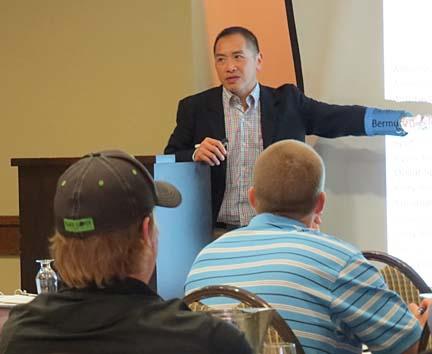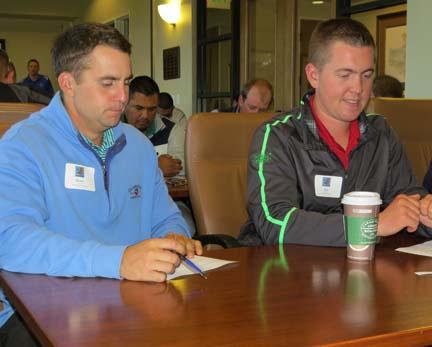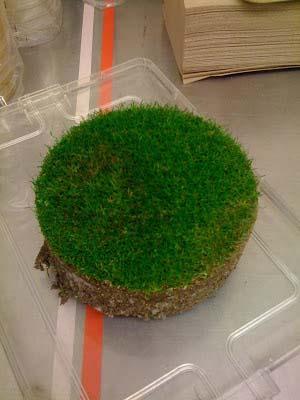 Few things are as disconcerting in this business as scouting the golf course first thing in the morning and finding signs of damage on putting greens that weren't there the day before. One thing that can intensify that stress and place a superintendent into a new level of discomfort, says Frank Wong, Ph.D., technical service specialist for Bayer Environmental Science, is to waste valuable time on a recovery program that doesn't work because the source of the damage was incorrectly diagnosed.
Few things are as disconcerting in this business as scouting the golf course first thing in the morning and finding signs of damage on putting greens that weren't there the day before. One thing that can intensify that stress and place a superintendent into a new level of discomfort, says Frank Wong, Ph.D., technical service specialist for Bayer Environmental Science, is to waste valuable time on a recovery program that doesn't work because the source of the damage was incorrectly diagnosed."Timely diagnosis is important for understanding what you have and what you have to do about it next," Wong said during this year's Northern California Golf Association Assistant Superintendent Boot Camp in Monterey. "If you misdiagnose something, it can put you behind the 8-ball. Smoking craters on the greens don't roll very fast."
Wong, who has worked for Bayer for the past three years and is based in Washington, D.C., spent 10 years as a turfgrass pathologist at the University of California at Riverside, so he knows a thing or two about turf damage on California golf courses. In fact, many West Coast superintendents still call him seeking his advice as well as for his diagnostic skills.
Correctly diagnosing a disease pathogen can be the difference, Wong told a group of about 40 assistants from throughout Northern California, between becoming a successful head superintendent and looking for a new career. Wong, who told the group he prefers to be called Dr. Frank rather than Dr. Wong because the latter "makes me sound like a proctologist", suggests using a checklist of five criteria, along with establishing a relationship with a single pathology lab for identifying disease pathogens expeditiously and working toward a solution.
"I've seen a lot of guys dismissed from the captain's chair because of disease. You, as assistants, are fighting all the time to get to the captain's chair," said Wong. "Once you get there, having a good handle on disease recognition and how to deal with it right away is a good strategy for staying there."
A relationship with a pathologist is important, because a single sample can contain many pathogens at the same time, but maybe only one that has manifested as a full-blown disease.
"A good lab will tell you what you what's in there," he said. "A great lab will tell you what disease you have and how to manage it."
In its 14th year, the NCGA boot camp is a two-day educational event for assistant superintendents that began in 2001 and includes seminars from industry experts on a wide variety of hot-button issues affecting golf course maintenance.
 Speakers at this year's event also included irrigation consultant Mike Huck, who is one of the state's most well-informed experts on water use; former superintendent Eric Greytok, who spoke on hiring, training and terminating employees; and Pat Finlen of The Olympic Club, who spoke on goal-setting and career advancement.
Speakers at this year's event also included irrigation consultant Mike Huck, who is one of the state's most well-informed experts on water use; former superintendent Eric Greytok, who spoke on hiring, training and terminating employees; and Pat Finlen of The Olympic Club, who spoke on goal-setting and career advancement. When he was a turf pathologist at UCR from 2001-2011, Wong said a list of five criteria - host, environmental conditions, cultural conditions, symptoms and signs - helped him zero in on the right pathogen when identifying a disease. Going through that list along with submitting a sample removes the guess work and results in an accurate diagnosis, which allows the superintendent to get on with the correct management plan and a path to recovery as soon as possible.
"Some things aren't controlled by certain fungicides, and some things get worse with certain cultural practices. The worst thing you want to do is to be in a hole and dig yourself into a deeper hole," Wong said.
During his time at Riverside, Wong estimated that the lab received up to 5,000 turf and soil samples. About half of those samples submitted, he said, showed no signs of disease.
"Other things can cause damage on turf. If you have a salt issue, but you think it's disease and you are spraying fungicides, you are going to stay behind that 8-ball," he said. "Making a correct diagnosis allows you to make the right management decision and buys you some time."
Host
If you know what species of turf you have, you have a good idea of what diseases could be affecting your stand, because certain diseases affect specific varieties of turf, says Wong.
"Anguina (gall nematodes) are only on Poa, but there are other things like fairy ring that are across the board, it doesn't care; and gray leaf spot is only on perennial ryegrass or kikuyugrass," he said.
"Everyone knows their species, but if you realize that every species has its own subset of diseases, you can eliminate all these other things you don't need to worry about."
Environmental conditions
Different fungi like different temperatures, and Wong says it is important to monitor daily temperatures, especially overnight lows, when concerned about disease pressure.
For example, snow mold likes it cold, while other diseases such as Pythium and dollar spot like it hot, particularly when overnight temperatures are 68 degrees Fahrenheit or above.
"It can be 120 degrees during the day, but it drops to 60 at night, you're good as far not developing Pythium, but if night time temperatures are above 68, there's something magic about that number, that allows Pythium to go out the door. When you look at the weather forecast and its going to be humid, or it's going to be wet and you have those high night time temperatures, that's a red flag for Pythium."
Cultural Conditions
Salts and nitrogen, Wong says, are factors that play a role in disease onset.
Salt-rich soil, especially in times of drought, makes turf especially susceptible to rapid blight, as is the case this year in Northern California, according to boot camp attendees.
"If it's salty, rapid blight is a possibility," he said. "If it's not salty, it's not going to be an issue."
Other problems are tied to nitrogen levels, including anthracnose, Waitea patch and dollar spot, which like lean, thin turf. Still others, like brown patch and Pythium blight like turf that is "fat and juicy," Wong says.
"Every disease has a distinct signature."
Symptoms and Signs
Turf managers often confuse these two criteria, or use them interchangeably, Wong says. But they are, indeed, two separate things.
Symptoms are the plant's response to being diseased, which could include changing colors and patterns of diseased or dying turf.
Signs, on the other hand are the physical manifestation of the pathogen itself, such as mycelia on a leaf blade.
Although he no longer works in the UCR lab, Wong still receives calls from West Coast superintendents seeking help. Each time, he goes through his five-point checklist, and then offers his opinion.
"I ask them all of these questions," he said. "You can usually guess within 90 percent of what someone has from 3,000 miles away by asking these questions. All our diagnoses at Riverside were based on these criteria."
Having a relationship with a lab is just as important as asking the right questions.
"You want to make sure what it is and that you make the right management decision," said Wong.
 "One thing that amazes me is guys are happy to drop $300 on a fungicide spray instead of $100 plus $20 for shipping to really make sure they know what they are dealing with.
"One thing that amazes me is guys are happy to drop $300 on a fungicide spray instead of $100 plus $20 for shipping to really make sure they know what they are dealing with. "Get in the habit of sending in samples so that when something big happens, it's not a crisis and you don't know who to send a sample to."
Wong suggests taking a large sample that also captures the root zone. Before submitting a sample, he also recommends superintendents first sprinkle them with water and placing them in a gallon-sized plastic bag to learn more about what is going on.
"Throw it on your desk overnight, nine times out of 10, if it's foliar, mycelia will pop out, or spores will be produced," he said. "If there's nothing there, you know it's not foliar and you need to focus on things that attack the roots, or the soil."
That's why samples should include the rootzone as well. Samples also should be taken from active, diseased turf, not dead turf that might be rife with other problems. They also should be tightly packed for shipping in something breathable that also holds it together, but doesn't cook if left in the sun on a shipping company's loading dock.
"It's a way of either identifying the fungi that develop, or excluding things that are not causing the problem," he said.
"We don't know if it's going to be foliar, or soil-borne or root-borne. I love a cup cutter-size sample. It's great to work with. If someone sends in a 1-inch-sized sample, it's hard to tell what's going on there. The easier it is for the diagnostician to find out what's going on, the easier it makes your job, so don't be stingy with the turf."

